- INGLEFIELD CLIP
- An elongated clip (usually of bronze, but also of a tough synthetic material)
with an eye and double-tapered gap in the beak part, making it easy for two to
be clipped together. The clips, spliced to the ends of halyards, are swivelled
to allow the halyards to move freely. With similar Inglefield clips spliced to
the ends of the hoist lines attached to flags, it allows for rapid and easy hoisting,
especially of signal flags (see also Appendix I and
halyard).
Please note that these clips were patented in 1890
by Lieut. (later Admiral) Edward Fitzmaurice Inglefield, RN, when serving as a
signals officer in the British Mediterranean Fleet.
- INGRAILED
- See engrailed.
- INNER EDGE
- A term that may be used in describing the edge of a hanging flag that is closest to the building
to which the pole is attached, and equivalent to the bottom edge of a conventionally hoisted flag (see also
hanging flag and outer edge).
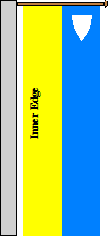
Please note that this term has been introduced by the Editors as no established
alternative could be found.
- INSET (or IN-SET)
- The term used when a charge or charges are set away from the edges of a
flag or the panel they occupy, but not in the centre of that same flag or
panel for examples see the illustration (with an inset red chevron) below
and inset border
below (also centred,
off-set towards and
orle).

Flag of Josefuv Dul, Czech Republic (fotw)
- INSET BORDER
- In vexillology the term for an unbroken border that is inset from the edges of a flag -
but see orle 1) (also
border and inset above).

Sultans Standard, Oman (fotw)
- INSIGNE (or INSIGNUM)
- An obsolete term for a flag or ensign (see also
insignia).
- INSIGNIA
- A term for the emblems of rank and distinction sometimes applied in the Middle
Ages to flags of varying sorts, and from which the word ensign probably derives
(see also ensign 5) and
insigne).
- INSIGNIA-BANNER
- The term from which ensign-banner was possibly derived.
- INSTITUTIONAL FLAGS/PENNANTS (OFFICIAL)
- Those flags or pennants that have been officially granted and/or formally approved by
the governing body/directing authority of an institution such as a university,
college, sporting club or other similar entity, and are recorded as such in their
official documentation or proprietary website (see also
institutional flags (unofficial) below
and official flag 1)).
Please note that this category includes only those
flags listed above, and that national, sub-national, personal and corporate flags
as defined separately herein are specifically excluded (see also
sports flag 2),
'national flag',
'sub-national flag',
'civic flag',
'personal flag' and
'corporate flag').
- INSTITUTIONAL FLAGS/PENNANTS (UNOFFICIAL)
- Those flags or pennants that purport to identify institutions, clubs and other entities,
but which have not been formally approved by the relevant governing body or directing
authority (see institutional flags (official) above
and official flag 1)).
Please note that it is a wide-spread practice, especially
among North American Universities and sporting clubs worldwide, for faculty members,
student bodies and supporters to display commercially manufactured flags which
differ from those formally approved, and which must, therefore, be designated
as unofficial. It should be noted also, that whilst manufacturers may often have
permission to use registered trade marks and logos of the organization concerned,
this does not give the resulting flags official status (see also
de facto).
- INSURANCE FLAG
- A term for an early 19th Century flag, now obsolete, showing the insurance number
of ship and usually issued by the appropriate marine insurance company
a number flag.
Please note that this is not an established term, but
has been introduced by the Editors since no contemporary source describing
such flags could be found.
- INTERLACED (or INTERFRETTED).
- A heraldic term for when two or more charges are arranged so as to form the appearance
of a united whole, as in the 1606 pattern of union jack or the symbol of the
International Olympic Committee braced, brased, embraced, entrelacι or interfretted
(see also charge 1),
fretty, union jack 1)
and union mark).
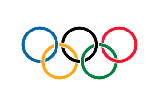

Flag of the International Olympic Committee; The 1606 Pattern of Union Flag, UK (fotw)
- INTERMENT FLAG
- See pall flag.
- INTERNAL PROPORTIONS
- See proportions 2).
- INTERNATIONAL CODE OF SIGNAL FLAGS (or ICS FLAGS)
- An internationally agreed set of flags of simple design to represent letters
of the Roman alphabet and numeral pennants, that can be hoisted singly or in groups
to convey meanings contained in the International Code of Signals (see also
blue peter,
complement,
diver below flag,
flag of distress,
hoist 2),
International Code of Signals,
make her number,
numeral pennant,
pilot flag,
quarantine flag and
signal flag).
- INTERNATIONAL CODE OF SIGNALS (or ICS)
- A code of single and multiple groups of letters with internationally agreed
meanings that can be transmitted by means of signal flags, radio or signal lanterns
(see also complement,
International Code of Signal Flags,
numeral pennant,
and signal flag).
Please note that the International Code of Signals was first
introduced (as the Commercial Code of Signals) in 1857, and whilst it has gone through
several revisions since that date, was also a further development of the code invented by
Captain Frederick Marryat RN, first published in 1817 (Marryats Code). Please note also
that the ICS is currently published by the International Maritime Organization, and that
all references to the code given in this Dictionary are taken from the 2005 Edition.
- INTERNATIONAL COLOUR (or COLOR) CODE
- That code prescribed by the
Federation Internationale des Associations Vexillogiques
(FIAV) for use by the international vexillogical community, which lists the colours
employed on flags: R = red, Y = yellow, V = green (from vert/verde etc, in the
Romance languages), B = blue, O = orange, P = purple, G = grey, N = black (from
noir/negro), W = white, Au = gold and Ag = silver. Lighter shades are indicated
by a minus sign thus light blue, for example, becomes B-, and darker by a plus
sign thus dark blue becomes B+ (with B++ being a very dark blue).
- INTERNATIONAL FLAG(S)
- 1) The generic term for any flag that is recognized as having international
significance , for more precise definitions however, see 2) below (also
Geneva Convention flag,
safe conduct flag, and
supra-national flag).
- 2) The flag of an organization which represents the interests of a number
of different countries, as in for example, that of the Organization of American
States, the Association of South East Asian Nations or of OPEC, or that represents
an international non-governmental organization such as the International Olympic
Committee (see also sports flag 3).
- 3) In the plural this term can also applied to a display of the worlds national
flags, such as that which appears outside the United Nations building in New York
(see also national flag).
Please note that the flags of most international
organizations fall into this category, however, the flags of the International
Red Cross and its equivalent organizations are at the same time Geneva Convention
flags, international flags and safe conduct flags.
- INVECTED (INVECKED or INVECQUED)
- (adj) A heraldic term for where a division in the field of a banner of arms or
shield, or the edge of an ordinary, is cut into a series of projecting curves or half
circles strung together - that is with the half-circles facing outward and the points
inward - invecked, envecked, or invecqued
(see also armorial bearings,
banner of arms,
coat of arms,
engrailed,
ordinary,
shield, and
scalloped).
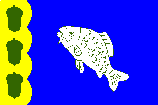

Flag of Sopψeθ, Czech Republic (fotw); Flag of Lazne Belohrad, Czech Republic
(fotw)
- INVERTED
- 1) On flags a term which may be used when a charge or charges, that are (or that
may be) orientated vertically, are shown as being turned upside down (see also
chevron,
pall and
pile).
- 2) In heraldry see reversed 2).
- INVERTED CHEVRON
- See chevron.
- INVERTED PALL
- See pall.
- INVERTED PILE
- See pile.
- INVERTED TRIANGLE
- See triangle.
- IRON CROSS
- The term (derived from an originally Prussian later German military decoration)
that describes a distinctly Germanic form of the cross pattee see
cross pattιe in appendix viii (also
Hanseatic cross).
![[Iron Cross]](../images/v/vxt-d670.gif)
![[German Naval Jack]](../images/v/vxt-d593.gif)
![[German Vice Admiral]](../images/v/vxt-d593a.gif)
Iron Cross 1939-45;
Naval Jack 18711918; Vice Admirals Flag, Germany (fotw)
Please note that the above term should only be used when the cross
pattιe being described is black and carries a white or silver border and/or is of Germanic origin.
- ISSUANT (or ISSANT)
- The heraldic term used when a charge emerges out of the base of a field or a chief, from an ordinary
or from the upper edge of a fess, or from a coronet. issant but see note below and naissant (also
charge 1),
chief,
coronet 1) and
fess in appendix VI).
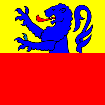
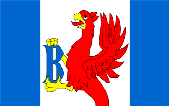

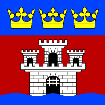

Flag of Givisez, Switzerland (fotw); Flag and Arms of Brusy, Poland (Jarig Bakker); Flag of
Jφnkφping, Sweden (fotw); Arms of Mδrkisch-Oderland, Germany (fotw)
Please note that the correct English heraldic term for a charge or figure
emerging from the side of a shield, banner of arms or a flag is
naissant.
![[Inglefield clip - left]](../images/v/vxt-d179.gif)
![[Inglefield clip - right]](../images/v/vxt-d181.gif)





![[Iron Cross]](../images/v/vxt-d670.gif)
![[German Naval Jack]](../images/v/vxt-d593.gif)
![[German Vice Admiral]](../images/v/vxt-d593a.gif)







